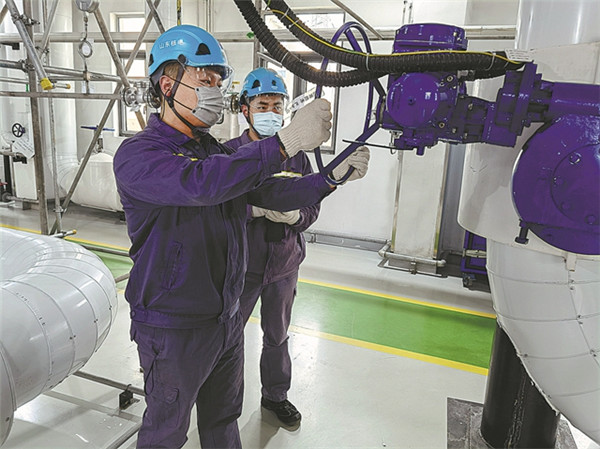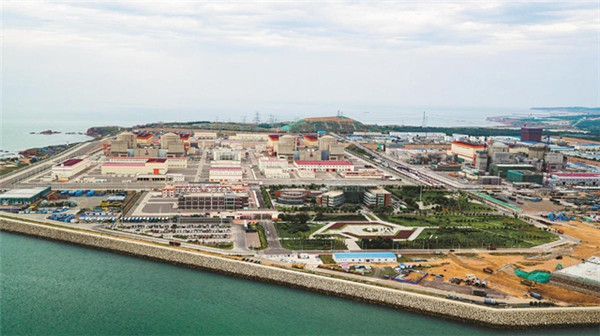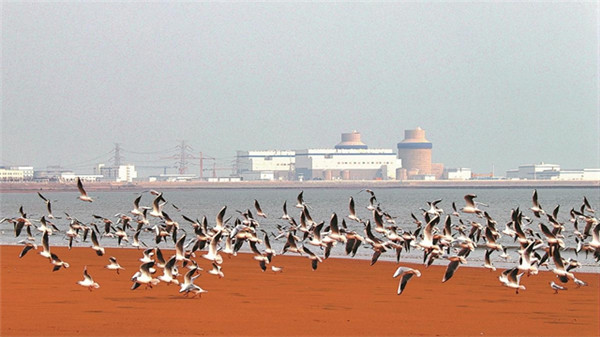Nuclear energy points way to greener, cleaner future
Updated : 2022-04-24
(China Daily)
 |
|
Engineers check the heating system at Shandong Nuclear Power Co in Haiyang. JIANG TAO/FOR CHINA DAILY |
In addition to supplying power, nuclear energy has been used for decades for heating and seawater desalination around the world.
Nuclear energy developers are now using new models of this form of clean energy to increase efficiency and reduce costs.
In Haiyang, Shandong province, a nuclear power plant on the Yellow Sea shore completed a mission this year to provide clean heating to all urban districts of the city throughout the winter.
Shandong Nuclear Power Co, a subsidiary of State Power Investment Corp and also the plant's operator, said the facility provided carbon-free heating for 143 consecutive days, serving an area of 5 million square meters and benefiting 200,000 residents in Haiyang, a county-level city under the jurisdiction of Yantai.
The plant's heating system is connected to the nuclear unit, making it the first commercial attempt in China to supply heat from traditional nuclear power.
Xiu Yaping, a Haiyang resident who lives about 20 kilometers from the plant, said clean heating keeps her family warm and contributes to a healthier environment.
"The temperature in our home remained at about 24 C during the winter," Xiu said, adding that when she turned all the heating appliances in the property on, the temperature rose to around 28 C, so she had to turn one or two of them off.
"The heating came on several days before the scheduled start of the winter heating season, and due to cold weather it was turned off days after the scheduled end of this period," she said.
Living near a thermal power plant, Xiu used to be worried by smoke pouring from its chimneys in winter when the plant started to burn coal to provide heating. She needed to clean her window sills every day to prevent soot forming.
"Now, I feel that our living environment is much cleaner," she said.
 |
|
Hongyanhe Nuclear Power Co in Dalian, Liaoning province, is scheduled to put the initial phase of a heating project into operation next winter. CHINA DAILY |
Safety a priority
Zhou Dadi, a senior researcher at the National Development and Reform Commission's Energy Research Institute, said that for more than three decades China has conducted research on using nuclear energy to provide heating, and has developed mature technologies.
Wu Fang, chairman of Shandong Nuclear Power Co, said, "Safety is the first prerequisite we need to consider when we develop nuclear power."
In 2019, trials to use steam from nuclear power for winter heating began in Haiyang, when more than 7,000 households started to use this new system, followed by a second phase last year that covered the entire urban area of the city.
The heating system extracts nonradioactive steam from the secondary circuit of the nuclear unit. The steam is then fed through a multistage heat exchanger at the plant.
Heat is subsequently channeled to a thermal power supply company to heat water flowing to consumers through municipal pipelines.
Wu said, "During this process, only heat is transferred, with no hot water being exchanged, ensuring the safety and reliability of nuclear energy heating."
Smart devices are used in the heating system to guarantee safety and efficiency.
Li Changke, assistant to the general manager of Fengyuan Thermal Power Co, which is cooperating with Shandong Nuclear Power Co, said, "Devices have been installed on the pipeline network to monitor any water leakage or damage to insulation layers."
The heating system at the nuclear plant is included in the city's smart heating platform.
"We use smart equipment to adjust the heating supply according to the weather," Li added.
 |
|
Shandong Nuclear Power Co's plant in Haiyang, Shandong province, provided heating produced by clean energy to all urban districts of the city during the winter. ZHANG XIAOHUI/FOR CHINA DAILY |
Important source
Nuclear power is an important source of energy with many environmental benefits, according to experts.
Wu said, "It contributes to solving environmental problems such as those linked to emissions of carbon dioxide and other gases from the burning of fossil fuels."
The use of nuclear energy in Haiyang has replaced 12 boilers that burned coal for central heating. To date, the clean energy has reduced carbon dioxide emissions by 330,000 metric tons, nitrogen oxide emissions by 2,021 tons, sulfur dioxide by 2,138 tons and soot by 1,243 tons, according to Shandong Nuclear Power Co.
Heating powered by nuclear energy has also improved the local marine environment, helping create livable surroundings for deep sea creatures.
Li said that in addition to environmental benefits, nuclear-powered heating has reduced costs for residents and eased the burden of local thermal power companies.
Xiu, the Haiyang resident, said her power bill fell by about 200 yuan ($31) during the winter, as nuclear heating costs per unit are cheaper than those for coal-fired heating.
Electricity, furnace maintenance and labor costs have been reduced for local thermal power companies.
Li added, "We don't need workers to operate furnaces, and we don't need to buy equipment to deal with air polluted due to coal-burning."
Several places in China have launched heating projects powered by nuclear energy amid efforts to curb carbon emissions.
The nation is poised to steadily develop the nuclear sector during the 14th Five-Year Plan period (2021-25) to reach its goals of peaking carbon emissions by 2030 and achieving carbon neutrality by 2060.
Last month, the government released its modern energy system plan as part of the 14th Five-Year Plan, emphasizing that China's share of non-fossil energy consumption will increase to about 20 percent.
Jiang Yi, an academician at the China Academy of Engineering and director of the Research Center of Architecture Energy Saving Affiliated to Tsinghua University, said that as a clean form of energy, nuclear power has the potential to develop the heating sector.
Central heating coverage in urban districts of China increased on average by 10 percent annually from 2000 to 2020, according to the National Bureau of Statistics.
Jiang said, "In places with nuclear power plants, urban heating problems can be solved by using the heat from this form of energy, without increasing emissions."
Shandong Nuclear Power Co said it plans to expand the heating area to all of the Jiaodong Peninsula in the east of the province.
The company has started the third phase of a 900-megawatt district heating project based on nuclear power. When put into service, this phase will cover 30 million sq m and is expected to meet demand from 1 million residents. Carbon reduction is likely to increase several times over, according to the company.
Wu said, "The third-phase project will also involve new energy and energy storage solutions to better manage the consumption of clean energy and cross-regional clean energy heating."
In eastern China, the first phase of a nuclear heating project at Qinshan Nuclear Power Station in Haiyan county, Zhejiang province, successfully completed a trial operation by providing heating for an area of 460,000 sq m for 100 consecutive days during the winter, benefiting 4,000 households.
China National Nuclear Corp, which operates the Qinshan plant, said that when it is fully operational the project is expected to provide heating to a total of some 4 million sq m of public facilities, residential communities and industrial parks in Haiyan.
Project launched
In the northeast, a major industrial area, an agreement on a heating project powered by nuclear energy was signed last month by Hongyanhe Nuclear Power Co and the northeastern branch of State Power Investment Corp.
The initial phase of the project, which is located in Hongyanhe town, Dalian, Liaoning province, is scheduled to be put into operation in the coming winter, providing heating to an area of 242,400 sq m.
The project is expected to make an important contribution to environmental protection in the northeast, especially Wafangdian, a county-level city of Dalian, where Hongyanhe is located.
Wang Bairun, a Hongyanhe official, said, "We usually use electricity and coal-fired furnaces to provide heating in the town, which is lagging behind when it comes to central heating systems in the urban area."
Coal-fired boilers in different areas of the town pose big challenges to environmental protection, especially during the heating season, Wang added.
Wang Jianguo, an engineer at the Hongyanhe nuclear plant, said, "The nuclear energy-powered project will substantially reduce pressure on the local government to protect the environment."

